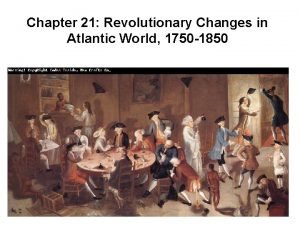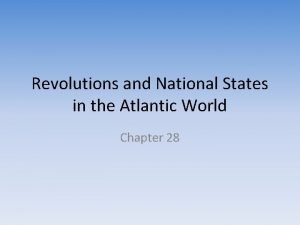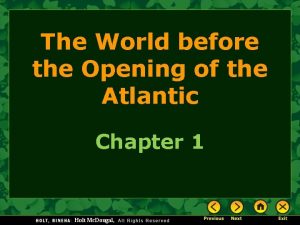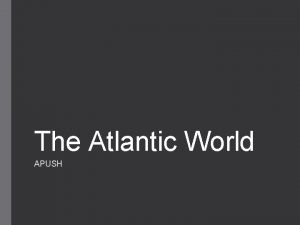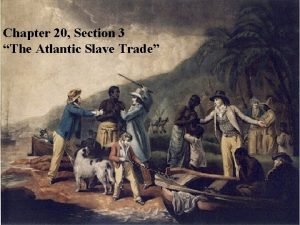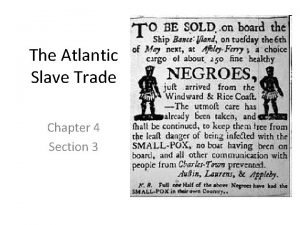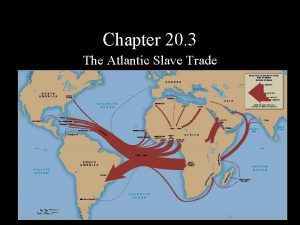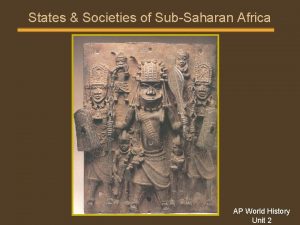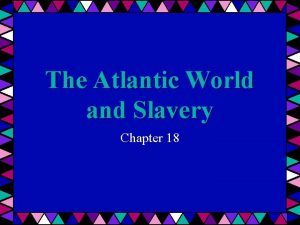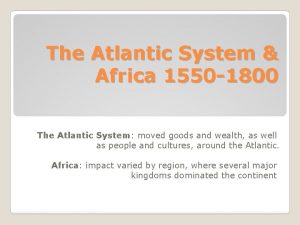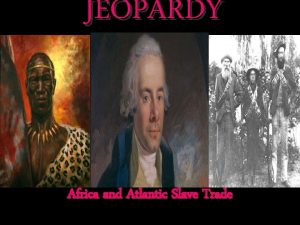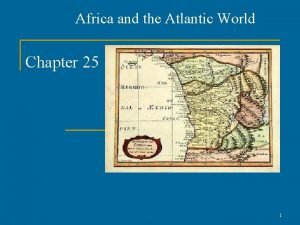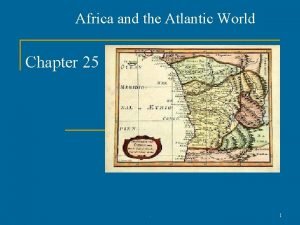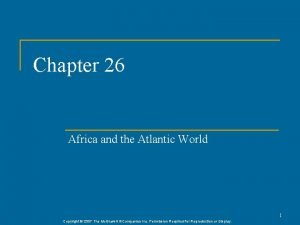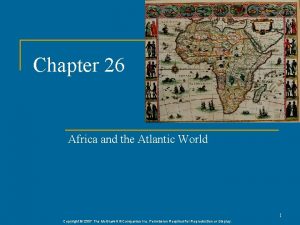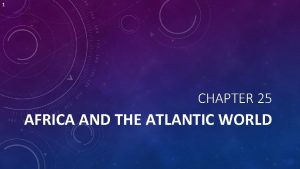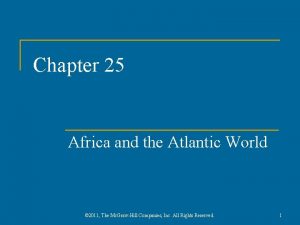Africa and the Atlantic World Chapter 26 1














- Slides: 14

Africa and the Atlantic World Chapter 26 1 Copyright © 2006 The Mc. Graw-Hill Companies Inc. Permission Required for Reproduction or Display.

The States of West Africa and East Africa n n Developed over 8 th-16 th centuries Kingdom of Ghana q q n n Not related to modern State of Ghana Major Gold Trader Mali Empire, 13 th century Songhay Empire, 15 th century q q Sunni Ali (r. 1464 -1493) created effective army, navy Musket-bearing Moroccan army destroys Songhay forces, regional city-states exert local control 2 Copyright © 2006 The Mc. Graw-Hill Companies Inc. Permission Required for Reproduction or Display.

The Middle Passage (Africa. Americas) n n African slaves captured by raiding parties, forcemarched to holding pens at coast Middle passage under horrific conditions q q n n 4 -6 weeks Mortality initially high, often over 50%, eventually declined to 5% Total slave traffic, 15 th-18 th c. : 12 million Approximately 4 million killed before arrival (approx 20% from each ship) 3 Copyright © 2006 The Mc. Graw-Hill Companies Inc. Permission Required for Reproduction or Display.

Effects of Slave trade n n n Africa lost generations of their fittest members Families torn apart Introduction of guns helped spread war and conflict throughout Africa Slaves contributed greatly to the economic and cultural development of the Americas: Haiti and Barbados could not have survived w/o their labor Increase of African-American populations (America and Brazil) 4 Copyright © 2006 The Mc. Graw-Hill Companies Inc. Permission Required for Reproduction or Display.

n n n Many new items introduced that traveled on triangle of trade. Introduction of firearms increases violence of preexisting conflicts More weapons, more slaves; more slaves, more weapons Sugar: major cash crop Creole languages 5 Copyright © 2006 The Mc. Graw-Hill Companies Inc. Permission Required for Reproduction or Display.

End of the Slave Trade Denmark abolishes slave trade in 1803, followed by Great Britain (1807), United States (1808), France (1814), Netherlands (1817), Spain (1845) n Possession of slaves remains legal n Clandestine trade continues to 1867 n Emancipation of slaves begins with British colonies (1883), then French (1848), U. S. (1865), Brazil (1888) n Saudi Arabia and Angola continue to the 1960 s n 6 Copyright © 2006 The Mc. Graw-Hill Companies Inc. Permission Required for Reproduction or Display.

Tradition and Change in East Asia Chapter 27

The Ming Dynasty (1368 -1644) • Ming government (1368 -1644) drove the Mongols out of China • Centralized government control; faced new invasions from the Mongols • Rebuilt and repaired the Great Wall to prevent northern invasions • Restored Chinese cultural traditions and civil service examinations • Emperor Yongle (r. 1403 -1424) experiments with sea expeditions, moves capital north to Beijing to deter Mongol attacks

Ming Collapse • Famine, peasant rebellions in early 17 th century; Rebels take Beijing in 1644 • Manchu (from Manchuria) fighters enter from the north and retake city; Manchus refuse to allow reestablishment of Ming dynasty • Originally pastoral nomads, organized powerful military force • Captured Korea and Mongolia first, then China • Remained an ethnic elite; forbade intermarriage with Chinese • Establish Qing (“Pure”) Dynasty

The Qing Dynasty (1644 -1911) • Manchus originally pastoral nomads, north of Great Wall • Chieftan Nurhaci (r. 1616 -1626) unifies tribes into state, develops laws, military • Establishes control over Korea, Mongolia, China – War with Ming loyalists to 1680 – Support from many Chinese, fed up with Ming corruption • Manchus forbid intermarriage, study of Manchu language by Chinese, force Manchu hairstyles as sign of loyalty 10

The “Son of Heaven” • Ming, Qing Emperors considered quasidivine • Hundreds of concubines, thousands of servants • Clothing designs, name characters forbidden to rest of population 11

Economic and Social Changes in China partly because of a result of influences abroad: Agricultural production increased (new foods from the Americas), global trade brought wealth to China • The Patriarchal Family: Filial piety understood as duty of child to parent; individual to emperor; Eldest son favored 12

Neo-Confucianism • It was a movement that synthesized Confucianism, Buddhism, and Daoism; developed during the Song Dynasty, it became the dominant philosophy during the Ming Dynasty • While loyalty to the government was an important feature, family structure was the foundation for all other relationships in one’s life; there were restrictions on merchant class, it existed not only in China but in Korea and Japan, placed great 13 value in education

Confucianism and Christianity • Jesuit missionaries tried to convert the Chinese, but it didn’t work • But, the Jesuits made China known to Europe (impact of paper) 14
 Ap world history chapter 25 africa and the atlantic world
Ap world history chapter 25 africa and the atlantic world Chapter 21 revolutionary changes in the atlantic world
Chapter 21 revolutionary changes in the atlantic world Revolutions and national states in the atlantic world
Revolutions and national states in the atlantic world The world before the opening of the atlantic
The world before the opening of the atlantic Anglicization apush
Anglicization apush Atlantic revolutions and their echoes
Atlantic revolutions and their echoes The atlantic slave trade chapter 20 section 3
The atlantic slave trade chapter 20 section 3 Chapter 16 atlantic revolutions global echoes
Chapter 16 atlantic revolutions global echoes Chapter 4 section 3 the atlantic slave trade
Chapter 4 section 3 the atlantic slave trade Chapter 20 section 3 the atlantic slave trade
Chapter 20 section 3 the atlantic slave trade Ap art history
Ap art history Hình ảnh bộ gõ cơ thể búng tay
Hình ảnh bộ gõ cơ thể búng tay Bổ thể
Bổ thể Tỉ lệ cơ thể trẻ em
Tỉ lệ cơ thể trẻ em

